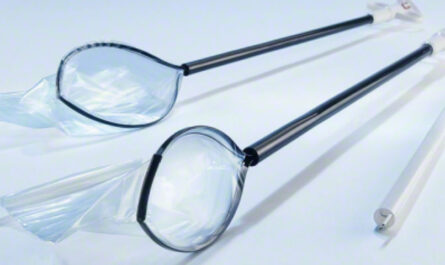
Surface plasmon resonance (SPR) is a technique used to study the interactions between molecules. When light shines on thin metal films such as gold or silver, the electrons at the surface can resonate or move together with the electromagnetic field of the light. This resonance phenomenon is known as surface plasmon resonance. It leads to a unique optical phenomenon that allows the measurement of molecular interactions at the metal interface in real-time without any labelling.
What is Surface Plasmon Resonance?
Surface plasmon resonance occurs when light reflects off a thin metal film, such as gold or silver, at a precisely defined angle known as the resonance angle. The SPR phenomenon originates from the collective oscillation of free electrons at the interface between a negative and positive dielectric material stimulated by incident light. It causes a decrease in the intensity of the reflected light at the resonance angle. Any change within the dielectric medium close to the metal surface, such as the binding of molecules, changes the local refractive index and alters the resonance angle. This shift in the resonance angle can be detected and is directly proportional to the mass bound at the surface. By monitoring the resonance angle as a function of time, binding events such as antigen-antibody interactions, DNA-ligand binding and cell adhesion can be measured in real-time.
The SPR phenomenon
In more detail, surface plasmons are oscillating electron charge density waves that exist at the interface of any two materials where the real part of the dielectric function changes sign, such as a metal and dielectric interface. It requires momentum matching between the incident photon and excited plasmons, which is achieved by exciting surface plasmons using a prism coupling method as shown in Figure 1. Plane-polarized light from a laser source passes through a prism and shines onto a thin gold film at the base. At a specific illumination angle, the momentum of the incident light matches that of the plasmons. Energy is then coupled from the photon to collective electron oscillations, generating an evanescent electromagnetic field that extends about 300nm from the metal surface into the dielectric. This resonance angle is very sensitive to any changes in the local refractive index and the mass bound to the sensor surface.
Detection of biomolecular interactions
SPR detection is based on monitoring changes in the refractive index at the sensor surface over time, as shown in Figure 2. In a typical binding assay, one binding partner (e.g. antigen) is immobilized onto the gold film surface. The interaction between this immobilized ligand and its binding partner (e.g. antibody) in the sample solution is measured by flowing the sample through the sensor flow cell. As the binding partner interacts with and binds to the immobilized ligand, it causes an increase in molecular mass at the sensor surface and changes the local density, altering the refractive index. This triggers a shift in the resonance angle which is directly proportional to the change in mass.
The association rate of binding provides information on the ‘on’ rate of binding while monitoring the dissociation or release of the binding partner after removal from the fluid flow cell can determine the ‘off’ rate or stability of the interaction. By fitting the association and dissociation sensorgrams to appropriate kinetic models, valuable kinetic parameters such as dissociation constant (KD) can be determined, providing insights into molecular binding events.
Analyzing biomolecular interactions
SPR is capable of both qualitative and quantitative analysis of biomolecular interactions. Qualitatively, the sensorgram provides details on whether an interaction occurs, how fast it occurs, and how stable it is. Features such as number of bindings sites, cooperative/non-cooperative binding and conformational changes can also be identified. Quantitatively, kinetic and affinity constants KD, kon and koff can be derived by fitting the binding curves to appropriate binding models. The measurement of binding affinities offers insights into drug potency, antibody effectiveness or protein mutation effects. The mass of the analyte bound can also be estimated based on the response units detected. Overall, SPR fingerprinting provides a wealth of kinetic and equilibrium information on biological interactions with high sensitivity, in real-time without any labelling.
Applications
Due to its label-free and real-time detection capabilities, SPR has found widespread application in diverse fields over the past few decades. The main applications include:
– Protein-protein interaction studies: Binding affinities and mechanisms of interactions between ligands, cytokines, antibodies and receptors etc can be studied.
– Drug discovery: Screening of compound libraries for drug leads based on binding strength and kinetics. Measurement of drug-target interactions.
– Antibody analysis: Epitope mapping, determination of monoclonal antibody affinity/specificity.
– Biomolecular interaction analysis: Studying membrane protein interactions, protein folding/unfolding, conformational changes etc.
– Cell-based assays: Examining cell adhesion, morphology changes and ligand-receptor interactions on whole cell surfaces.
– Detection of DNA/RNA interactions: Studies on DNA-protein, RNA-peptide binding involved in gene regulation etc.
– Environmental monitoring: Detection of toxins, pollutants, pesticides and their interaction with receptors.
– Food safety testing: Pathogen detection, mycotoxin binding studies relevant to analytical research.
The versatile capabilities of SPR towards label-free, real-time and high sensitivity detection have revolutionized biomolecular interaction analysis across diverse domains of drug discovery, life sciences research and quality control applications. It remains a powerful optical technique with expanding application potential.
Conclusions
In summary, surface plasmon resonance spectroscopy is a sophisticated optical detection technique that leverages the phenomenon of surface plasmons to study biomolecular interactions. It enables direct, real-time measurements of binding events without the need for labelling by tracking changes in the refractive index upon molecular binding. Information regarding both kinetic and affinity constants can be determined from the sensorgrams, allowing quantitative analysis of interactions. With the advantages of high sensitivity, label-free detection and versatile applications, SPR continues to find widespread use across domains in analyzing diverse biomolecular recognition processes. It remains an indispensable tool for investigating biomolecular interactions.
*Note:
- Source: Coherent Market Insights, Public sources, Desk research
2. We have leveraged AI tools to mine information and compile it



